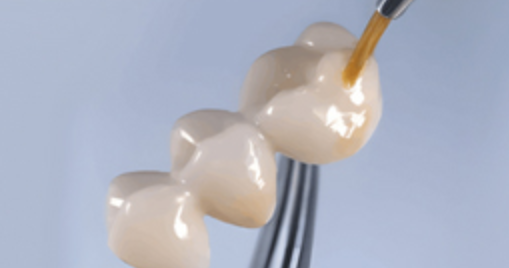1. Why zirconium oxide?
Mechanics King
3% yttria-stabilized tetragonal zirconium oxide (3Y-TZP), bending strength 900–1200 MPa, the same level as aviation aluminum alloy;
after 5 years of chewing simulation, the fracture rate of the monolithic posterior bridge is 0%.
Biological inertness
Metal-free, non-sensitizing, non-corrosive, MRI zero artifacts; a one-year clinical trial showed that the surrounding gingival bleeding
index and plaque index were not statistically different from natural teeth.
Aesthetic revolution
The latest 4Y/5Y formula + three-dimensional layered dyeing technology makes zirconium oxide as transparent as glass ceramics, but 3 times stronger than glass ceramics.
2. What does it look like clinically?
Single crown:
• Anterior teeth——4Y-highly transparent zirconium oxide, 0.5 mm ultra-thin veneer can cover the color of the abutment teeth.
• Posterior teeth - monolithic all-zirconium crowns, no need for veneer porcelain, completely bid farewell to the risk of porcelain chipping.
Bridge:
• The one-year survival rate of three-unit posterior bridges is 100%, and the veneer porcelain chipping rate is 0% (monolithic).
Implant:
• The 3-year retention rate of one-piece zirconia implants is 98.5%, and the marginal bone resorption is < 0.5 mm; there is no significant
difference in clinical performance with titanium implants in the anterior area.
Abutment:
• The personalized CAD/CAM zirconia abutment can be bent 30°, and patients with thin gingiva can also "not expose metal".

3. How should doctors choose?
Strength vs. transmittance
• The posterior teeth have strong bite force → choose 3Y/4Y high-strength monolithic;
• The anterior teeth have high aesthetics → choose 5Y high-transparency + veneer or gradient dyeing monolithic.
Preparation amount
• High-transparency zirconia can make 0.5 mm ultra-thin veneers, making minimally invasive preparation possible.
Surface treatment
• Fine machining + polishing can maintain strength; rough diamond adjustment will reduce 20-30%, requiring secondary sintering to compensate.
Bonding or screw retention
• Patients with high occlusal force are preferred to screw retention to prevent micro-leakage of the bonding seam; ultra-thin crowns can be bonded
with resin, but rubber dams are required to isolate moisture.
4. The five most concerned issues of patients
“How long can it be used?”
There are limited 20-year follow-up literature, but the 5-7-year retention rate is > 95%, which is better than metal porcelain.
“Will it collapse?”
The monolithic zero-veneer porcelain design reduces the probability of porcelain collapse directly to 0.
“Will the color be fake?”
Three-dimensional layering + fluorescent staining, the color difference with adjacent teeth under natural light is < 1.5 ΔE.
“Will it affect the examination?”
All-ceramic material, MRI/CT has no artifacts, and no disassembly is required.
“Is it expensive?”
The cost is indeed higher than metal porcelain, but it has a longer lifespan and fewer complications, and the long-term cost-effectiveness is higher.
5. 4 keywords for the next 3-5 years
The paradox of high transparency and high strength is solved - 4Y/5Y formula + nano gradient structure, which improves light transmittance and fracture toughness at the same time.
AI design - big data training algorithm, one-click generation of zirconia crowns that best suit the patient's tooth morphology.
3D printing - direct printing of complex root-shaped implants, reducing milling waste and shortening delivery cycle.
Antibacterial surface - silver or copper-doped zirconia coatings, reducing the incidence of peri-implantitis, clinical trials have been launched.
Conclusion
From the "metal era" to the "all-ceramic era", and then to today's "zirconia multidimensional era", dental restorative materials are undergoing a silent but profound revolution.
It makes teeth not only "fillable", but also "invisible, long-lasting, and real". If you are considering a new tooth, please remember: not all all-ceramic teeth are called zirconia;
and real zirconia has long surpassed the simple definition of "white" and "hard", becoming a "third set of teeth" that integrates engineering, aesthetics and biology.